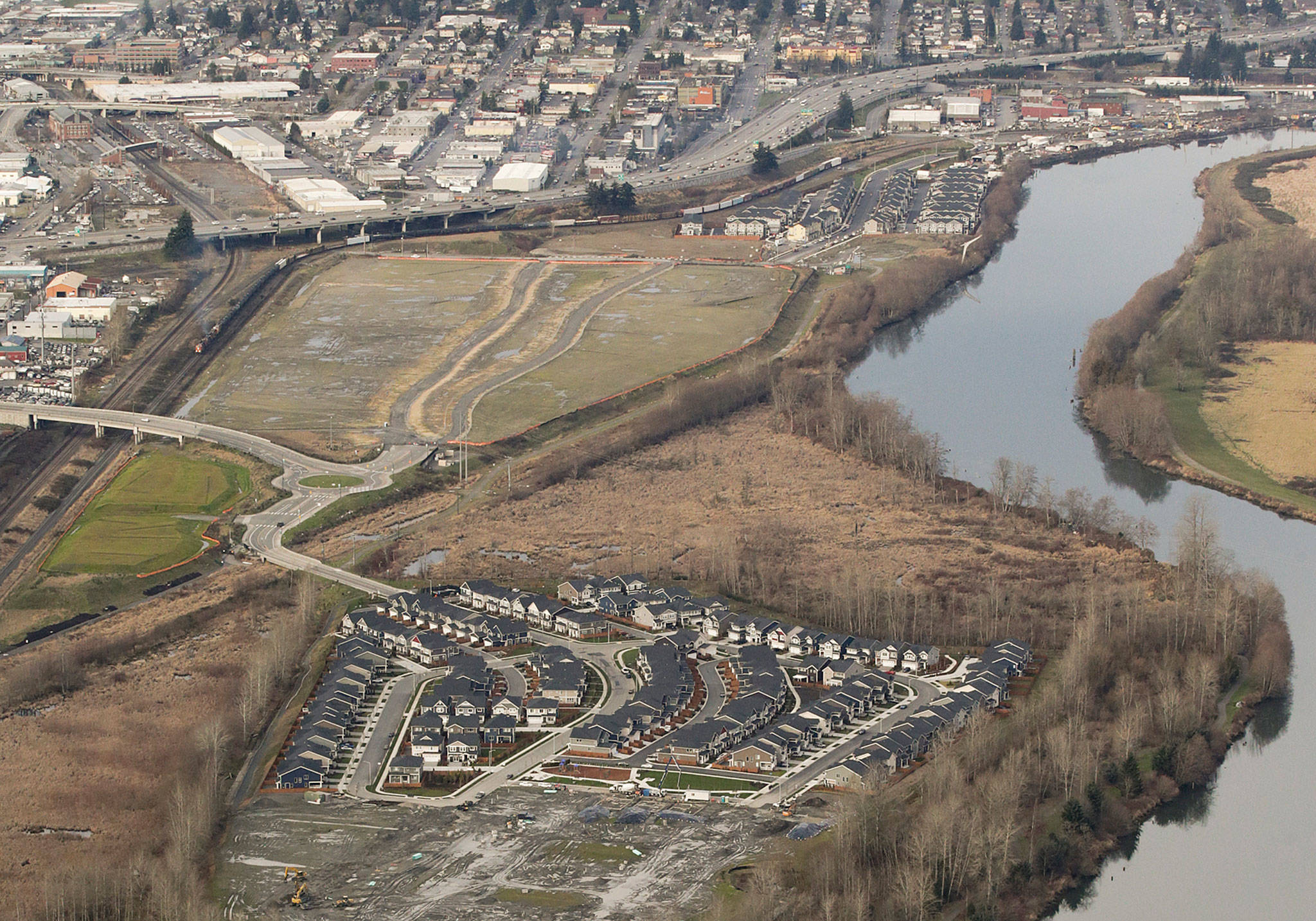EVERETT — A new plan for the last parcel of the Riverfront development has the unanimous backing of the Everett City Council. The change will bring 1,250 housing units, 2,700 parking spaces, a movie theater, grocery store, and retail and restaurant space to the former landfill site along the Snohomish River.
“The Riverfront agreement ushers in a new era for Everett,” said Dan Eernissee, Everett’s economic development director, addressing councilmembers before the vote Wednesday night. “When complete, Riverfront will draw in new residents from the millions of travelers along Interstate 5. And, in so doing, will transform what was once a repellent eyesore, a repellent nose sore for that matter, into an attractive, amenity-filled neighborhood.”
Redevelopment of the landfill site was originally envisioned as a “lifestyle entertainment center,” which included a large retail area. But as shopping habits have evolved over the last decade, a commercial center is no longer viable, according to the city and Shelter Holdings, the developer.
The city approved a master plan for the area in 2009, after extensive environmental cleanup. Plans for building it out have evolved.
“The original vision didn’t accomplish what our residents or our community wanted,” said Mayor Cassie Franklin, in an interview after the vote. “This is a better project.”
The entire Riverfront development is composed of three parcels. On the northern portion, the former Eclipse Mill site, 190 townhouses have been built. On the southernmost edge of the land where the Simpson Mill once stood, 235 single-family homes now sit.
The middle parcel is the last section to get redeveloped. Shelter Holdings will build out the project in six phases starting this summer. The plan for that initial stage includes constructing about a quarter of the total housing units, a grocery store and movie theater with a public plaza in front.
The residential buildings will be six stories tall with five floors of housing over a level of retail or restaurant space.
A main road, which will meander through the mixed-use complex and connect to the other two residential sites, is set to be completed during the first phase. Shelter Holdings aims to have the road open by summer 2020, according to Natalie Quick , a spokesperson for the project. The street is currently only open to emergency vehicles.
Shelter also is planning to add a 3-acre public park during the first phase. A restroom will be added later.
The next four stages would add mostly residential space, atop a floor of retail. A medical office building could also go in early in the build-out.
In the last phase, Shelter is planning a 250-room hotel and up to 100,000 square feet of office space. Changes could occur as the project is constructed. Major ones would require council approval.
Shelter hopes to open the first phase by the middle of 2021 and complete the entire project by 2034, Quick said.
Included in the deal is a buy back option for the city, if the first phase isn’t completed by July 2024.
Katrina Lindahl, who lives in the Riverside neighborhood, was one of two people who spoke during the public hearing before the vote.
She supported the project, and was glad that a big-box store was no longer in the plans. But Lindahl wanted to see a stronger connection to the riverfront, rather than centering buildings along the main road.
“Much of the retail and gathering spaces are focused on this boulevard, and any retail facing the river is separated from the river by a large parking lot,” she said.
Councilmembers also approved allowing Shelter to participate in the city’s multifamily tax exemption program. In exchange for a property tax break, a percentage of units are rent restricted for a period of time.
Across the development, 10 percent of the units must be affordable to households that earn 80 percent or less than the area median income. To be considered affordable, housing costs can’t exceed 30 percent of monthly income.
Another 10 percent are reserved for “moderate-income households” that make between 80 percent to 115 percent of the area median household income. Snohomish County’s area median family income is $108,600.
The tax exemption will last for 12 years. Property taxes will still be paid on the value of the land and on the non-residential parts of the buildings.
The goal of the multifamily tax exemption program is “to stimulate the construction of new multifamily housing and the rehabilitation of existing vacant and underutilized buildings,” according to city documents.
“It’s expensive to build multifamily housing and redevelop brownfield sites,” Eernissee said in an interview after the city council vote. “(The multifamily tax exemption program) makes projects happen that wouldn’t normally happen.”
It’s cheaper for the city to serve 1,250 units at Riverfront than build enough roads to support that many single-family homes, Eernissee said.
Lizz Giordano: 425-374-4165; egiordano@heraldnet.com; Twitter: @lizzgior.
Talk to us
> Give us your news tips.
> Send us a letter to the editor.
> More Herald contact information.

























